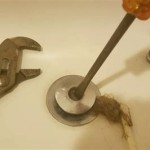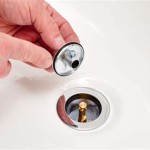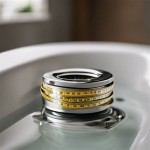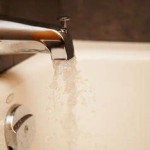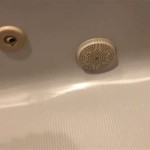How To Remove Rust From Bathtub Drain
Rust in a bathtub drain is a common problem, particularly in areas with hard water or older plumbing systems. The presence of rust not only detracts from the aesthetic appeal of the bathroom but can also, over time, compromise the functionality of the drain, potentially leading to clogs and slow drainage. Addressing rust promptly and effectively is essential for maintaining the integrity and hygiene of the plumbing system.
Several factors contribute to the formation of rust in bathtub drains. The primary culprit is the oxidation of iron or steel components due to prolonged exposure to water. Water, especially hard water containing minerals like calcium and magnesium, accelerates this process. The drain stopper, flange, and connecting pipes are all susceptible to rust. Furthermore, existing rust on nearby fixtures or plumbing can leach into the drain, exacerbating the problem. Understanding these causes is crucial for implementing preventative measures after removing the rust.
Before undertaking any rust removal process, it is imperative to ensure personal safety. This involves wearing appropriate protective gear, such as rubber gloves, to prevent direct contact with cleaning solutions and potentially sharp rust fragments. Eye protection, such as safety glasses, is also recommended to shield the eyes from splashes or debris. Adequate ventilation is essential, particularly when using chemical-based rust removers. Opening windows or using a ventilation fan can help dissipate any fumes.
The following sections outline several methods for removing rust from a bathtub drain, ranging from basic household solutions to more specialized rust removal products. The choice of method will depend on the severity of the rust and personal preference.
Using Vinegar and Baking Soda for Mild Rust Removal
Vinegar and baking soda offer a gentle, environmentally friendly approach to removing mild rust from a bathtub drain. This method relies on the mild acidity of vinegar and the abrasive properties of baking soda to loosen and dislodge rust particles. It is particularly suitable for tackling surface rust and preventing its further development.
The first step is to prepare the baking soda paste. Combine baking soda with a small amount of water until a thick, pasty consistency is achieved. The amount of baking soda and water will depend on the size of the area affected by rust. The paste should be thick enough to adhere to the drain and rust. This paste acts as a gentle abrasive agent that will help lift the rust.
Next, apply the baking soda paste liberally to the affected areas of the drain, ensuring complete coverage of the rust. Allow the paste to sit for at least 30 minutes, or ideally for several hours, to allow it to penetrate the rust. The longer the paste remains in contact with the rust, the more effective it will be in loosening it. For severely rusted areas, the paste can be left on overnight.
After allowing the baking soda paste to sit, pour a cup of white vinegar down the drain. The vinegar will react with the baking soda, creating a fizzing action that helps to further loosen the rust and debris. The acetic acid in the vinegar helps dissolve the rust, making it easier to remove. Allow the vinegar and baking soda mixture to fizz for approximately 15-30 minutes.
After the fizzing subsides, scrub the drain thoroughly with a stiff-bristled brush or an old toothbrush to remove the loosened rust. Apply moderate pressure while scrubbing to ensure effective removal. The scrubbing action dislodges the rust particles that have been softened by the baking soda and vinegar. Rinse the drain thoroughly with hot water to flush away any remaining rust and baking soda residue. Repeat the process if necessary until the rust is completely removed.
Following the rust removal process, drying the drain thoroughly can help prevent future rust formation. Use a clean cloth to wipe away any excess moisture. Regular application of a rust preventative, such as a silicone-based spray, can also help protect the drain from future corrosion.
Employing Lemon Juice and Salt for Rust Removal
Lemon juice and salt offer a natural and effective method for removing rust from a bathtub drain, particularly for lighter rust accumulation. The acidity of lemon juice, combined with the abrasive nature of salt, works to dissolve and loosen rust particles effectively. This method is a good alternative for those seeking a less chemically intensive approach.
To begin, thoroughly rinse the bathtub drain with water to remove any loose debris or surface dirt. This ensures that the lemon juice and salt can directly target the rust without interference from other contaminants. Ensuring the drain is clean is a crucial preliminary step.
Next, sprinkle a generous amount of table salt directly onto the rusted areas of the drain. The salt acts as an abrasive agent, helping to dislodge the rust particles as it is scrubbed. Use a sufficient quantity of salt to ensure complete coverage of the rust. The crystals of salt will assist in the removal of the rust as well as helping the lemon juice to penetrate the rust.
Squeeze fresh lemon juice over the salted areas, ensuring the salt is fully saturated with the juice. The citric acid in lemon juice dissolves the rust, making it easier to remove. The amount of lemon juice needed will vary based on the extent of the rust. An alternative to fresh lemon juice is concentrated lemon juice, which is just as effective.
Allow the lemon juice and salt mixture to sit on the rust for at least 2-3 hours, or preferably overnight for heavier rust buildup. The extended soaking period allows the citric acid to effectively break down the rust. This waiting period is essential for allowing the solution to work.
After the soaking period, use a stiff-bristled brush to scrub the rusted areas vigorously. The salt will act as an abrasive, helping to lift the loosened rust from the metal surface of the drain. Apply firm, consistent pressure while scrubbing to maximize the effectiveness of the process.
Rinse the drain thoroughly with hot water to wash away any remaining rust, salt, and lemon juice residue. Inspect the drain to ensure all rust has been removed. If any rust remains, repeat the process as needed. If the first application doesn't completely remove the rust, a second application of lemon juice and salt can be applied.
Once the rust is completely removed, dry the drain thoroughly with a clean cloth. Proper drying is crucial to prevent the recurrence of rust. Consider applying a rust inhibitor or sealant to protect the drain from future rust formation, especially in areas with hard water. Using a rust inhibitor will help prevent the oxidation from continuing.
Utilizing Commercial Rust Removal Products
For stubborn or extensive rust, commercial rust removal products often provide the most effective solution. These products are formulated with chemicals specifically designed to dissolve rust quickly and efficiently. However, it is imperative to use these products with caution and to follow the manufacturer's instructions meticulously.
Prior to using any commercial rust remover, ensure adequate ventilation in the bathroom. Open windows or use a ventilation fan to minimize exposure to fumes. Wear protective gloves and eye protection, such as safety glasses, to prevent skin and eye irritation. These are necessary precautions when using powerful chemicals.
Select a rust remover specifically designed for use on plumbing fixtures. There are various types available, including gels, liquids, and sprays. Choose a product that is appropriate for the specific material of the bathtub drain. The product label should specify the suitable materials, ensuring that it won't damage the drain.
Apply the rust remover according to the manufacturer's instructions. This typically involves applying the product directly to the rusted areas and allowing it to sit for a specified period. Adhering to the recommended application time is crucial for optimal results and to prevent damage to the drain. Do not exceed the application time as this can cause damage.
After the recommended soaking time, thoroughly scrub the drain with a stiff-bristled brush to remove the loosened rust. The commercial rust remover should have significantly softened or dissolved the rust, making it easier to scrub away. Use a brush to apply the product to hard to reach areas.
Rinse the drain copiously with water to remove all traces of the rust remover and dissolved rust. Ensure that no residue remains, as some rust removers can be corrosive if left on the surface. Check all areas of the drain to ensure that the remover is removed.
After rinsing, inspect the drain for any remaining rust. If necessary, repeat the application of the rust remover for particularly stubborn rust patches. If the first application removes most, but not all rust, a second application is appropriate.
Once all rust has been removed, dry the drain thoroughly to prevent future rust formation. Apply a rust inhibitor or sealant to protect the drain from further corrosion, particularly in areas prone to rust. Regular maintenance and preventative measures will help prolong the lifespan of the drain and prevent rust from recurring. Apply the corrosion inhibitor on a regular basis.

3 Easy Ways To Remove Rust From A Bathtub Wikihow

How To Remove Rust Stains From Sink Tub Mr Handyman

Fix And Prevent Corrosion On A Bath Tub Drain Hometalk

Get Rid Of Sink And Bathtub Rust Stains

Rust In Bath Tub Hometalk

3 Easy Ways To Remove Rust From A Bathtub Wikihow

Rust In Bath Tub Hometalk

How To Fix The Enamel On A Bathtub Stop Rust Formation

How To Remove Rust Stains From A Porcelain Tub Or Sink Cabana State Of Mind

Rust In Bath Tub Hometalk

